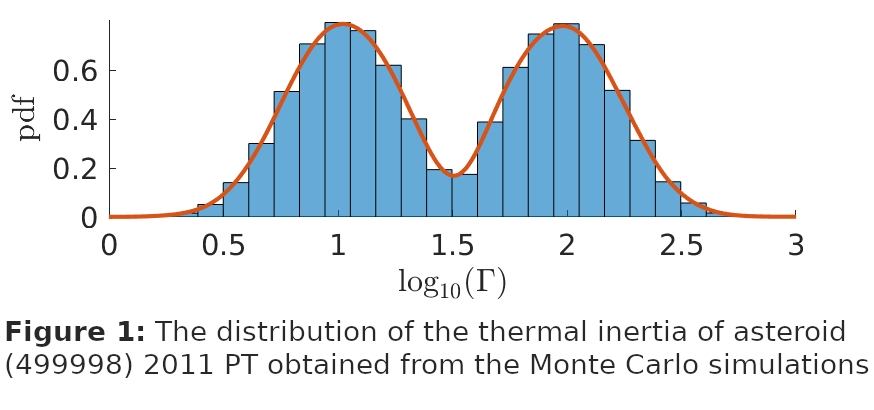Demystifying Near-Earth Asteroids
- University of Belgrade, Faculty of Mathematics, Department of Astronomy, Belgrade, Serbia (bojan@matf.bg.ac.rs)
Introduction: Knowledge of the physical and surface properties of most NEAs lags far behind the current rate of their discoveries. Still, asteroid surfaces and internal structures are very diverse, and knowledge derived from a limited number of asteroids typically could not be safely extrapolated to a large number of objects. The situation calls for an alternative approach that permits estimating asteroids' properties for a much larger number of NEAs.
The Demystifying Near-Earth Asteroids (D-NEAs) is the Planetary Society STEP Grant 2021 project aiming to develop a novel method that directly characterises asteroids primarily from ground-based data. In particular, the project's objective is to develop a model to characterise surface thermal properties.
Methodology: The idea is based on the Yarkovsky effect, a non-gravitational phenomenon that causes objects to undergo orbital semi-major axis drift as a function of their size, orbit, and material properties. The effect joins together the asteroid's orbital dynamics, composition, and physical properties. Our idea to derive the surface thermal properties of near-Earth objects is built around these facts.
Theoretical models of the Yarkovsky effect allow predicting the semi-major axis drift, assuming a set of input parameters is available. On the other hand, astrometric observations and orbit determination procedures allow detecting the semi-major axis drift in motion of an asteroid. Therefore, at least one asteroid's property that determines the drift rate could be estimated by comparing the model’s predicted (da/dt) and measured (da/dt)m magnitude of the effect, as given by Equation 1:
Especially critical are the thermal conductivity uncertainties that span a range of about four orders of magnitude (Delbo et al. 2015). It is also a key to proper estimation of the thermal inertia, which could be diagnostic of surface porosity and cohesion, and, therefore, for the possible presence of the regolith layer at the surfaces.
Results: The first results obtained by Fenucci et al. (2021) are encouraging but also intriguing at the same time. We found that a small super-fast rotator, near-Earth asteroid 2011 PT, should have low thermal inertia (Γ < 100 J m-1 K-1 s-1/2) to maintain the high Yarkovsky drift detected from astrometry.

Future prospect: This exciting result opens the possibility for further studies. There are, however, several essential features that are not included in the preliminary model. To fully exploit the potential of our approach, it is necessary to extend the model by including, for instance, Yarkovsky correction for eccentric orbits, heterogeneity in object’s density, or variable thermal inertia along the orbit (Rozitis et al. 2018). The D-NEAs project will address these issues and develop a robust model which will apply to a much larger number of asteroids.
References
-
Delbo, M., Mueller, M., Emery, J.P., Rozitis, B., Capria, M.T.: Asteroid Thermophysical Modeling. Asteroids IV, p.107-128, University of Arizona Press, Tucson, 2015.
-
Fenucci, M., Novakovic, B., Vokrouhlicky, D., Weryk, R.J.: Low thermal conductivity of the super-fast rotator (499998) 2011 PT. Astronomy and Astrophysics, id 647, 2021.
-
Rozitis, B., Green, S.F., MacLennan, E., Emery, J.P: Observing the variation of asteroid thermal inertia with heliocentric distance. MNRAS, 477, 1782, 2018.
How to cite: Novakovic, B., Fenucci, M., Marceta, D., and Pavela, D.: Demystifying Near-Earth Asteroids, Europlanet Science Congress 2022, Granada, Spain, 18–23 Sep 2022, EPSC2022-159, https://doi.org/10.5194/epsc2022-159, 2022.

